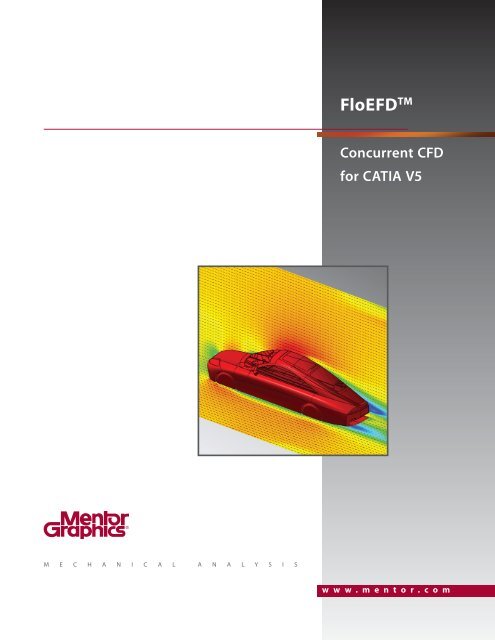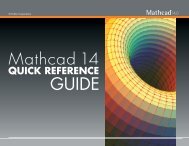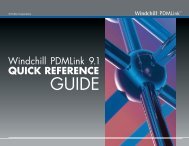FloEFD for CATIA V5 Brochure - Mentor Graphics
FloEFD for CATIA V5 Brochure - Mentor Graphics
FloEFD for CATIA V5 Brochure - Mentor Graphics
Create successful ePaper yourself
Turn your PDF publications into a flip-book with our unique Google optimized e-Paper software.
M e c h a n i c a l a n a l y s i s<br />
<strong>FloEFD</strong> TM<br />
Concurrent CFD<br />
<strong>for</strong> <strong>CATIA</strong> <strong>V5</strong><br />
www.mentor.com
Overview<br />
<strong>FloEFD</strong> <strong>for</strong> <strong>CATIA</strong> <strong>V5</strong> belongs to a new breed of CFD tools called<br />
Concurrent CFD. <strong>FloEFD</strong> is a fully embedded Computational Fluid<br />
Dynamics (CFD) tool <strong>for</strong> <strong>CATIA</strong> <strong>V5</strong>. <strong>FloEFD</strong> enables you to analyze<br />
and optimize complex fluid flow and heat transfer effects on your<br />
designs directly inside <strong>CATIA</strong> <strong>V5</strong>.<br />
<strong>FloEFD</strong> has the same “look and feel” as <strong>CATIA</strong> <strong>V5</strong> so you are not<br />
<strong>for</strong>ced to learn a new interface simply to use the software. And<br />
unlike other CFD programs, <strong>FloEFD</strong> interacts directly with the<br />
native 3D CAD data defined by <strong>CATIA</strong> <strong>V5</strong> - with no translation or<br />
copies - in order to keep pace with on-going design changes.<br />
Concurrent CFD can reduce simulation time by as much as 65 to<br />
75% in comparison to traditional CFD tools and enables users to<br />
optimize product per<strong>for</strong>mance and reliability while reducing<br />
physical prototyping and development costs without time or<br />
material penalties.<br />
If you use <strong>CATIA</strong> <strong>V5</strong>, you ought to take a closer look at <strong>FloEFD</strong> -<br />
the fluid flow and heat transfer simulation tool that fits into your<br />
design process without requiring you to change the way you<br />
design products.<br />
engineers…<br />
<strong>FloEFD</strong> <strong>for</strong> <strong>CATIA</strong> <strong>V5</strong> was developed <strong>for</strong><br />
engineers by engineers. So it works<br />
the way you do.<br />
<strong>FloEFD</strong> is fully embedded into<br />
<strong>CATIA</strong> <strong>V5</strong> and has the same look and<br />
feel as <strong>CATIA</strong> <strong>V5</strong>. Since <strong>FloEFD</strong><br />
interacts directly with native <strong>CATIA</strong> <strong>V5</strong><br />
data, you can create models and<br />
immediately analyze and improve<br />
them without having to deal with any<br />
file transfer or data loss.<br />
<strong>FloEFD</strong> is also extremely easy to use -<br />
as a matter of fact, most users report<br />
that they can use <strong>FloEFD</strong> with less<br />
than 8 hours of training.<br />
In short, <strong>FloEFD</strong> helps you get on with<br />
the business of improving product<br />
per<strong>for</strong>mance/ functionality and<br />
reducing prototyping costs without<br />
requiring you to become a full-time<br />
fluid dynamics specialist.<br />
www.mentor.com<br />
cFD specialists…<br />
<strong>FloEFD</strong> <strong>for</strong> <strong>CATIA</strong> <strong>V5</strong> co-exists quite<br />
easily alongside your traditional CFD<br />
programs and will increase your overall<br />
productivity.<br />
By enabling design engineers to<br />
conduct first-level CFD analyses<br />
directly from CAD models to remove<br />
unreasonable options with <strong>FloEFD</strong>,<br />
you’ll be able to focus your time and<br />
energy on research and conceptual<br />
design. With <strong>FloEFD</strong> you can take<br />
advantage of advanced meshing<br />
technology which makes analysis of<br />
real-world designs even faster and<br />
more accurate.<br />
Finally, as the resident analysis expert,<br />
you will be able to use your extensive<br />
knowledge to help guide the design<br />
engineering team at your organization.<br />
“<strong>FloEFD</strong> is a natural extension of traditional CFD that is easier to<br />
use and more intuitive <strong>for</strong> mechanical engineers.”<br />
G. Bertels, Senior Engineer, Bronswerk Heat Transfer BV<br />
Managers…<br />
<strong>FloEFD</strong> <strong>for</strong> <strong>CATIA</strong> <strong>V5</strong> supports your<br />
“lean engineering” ef<strong>for</strong>ts directly by<br />
reducing the burden on your budget<br />
and saving thousands of man-hours.<br />
<strong>FloEFD</strong> enables broad-based<br />
mechanical design engineers to<br />
per<strong>for</strong>m fluid-flow and heat transfer<br />
simulations directly from their 3D CAD<br />
models, in a fraction of the time taken<br />
by other CFD codes, and with very<br />
little training:<br />
■ Reduce prototyping costs<br />
drastically by replacing physical<br />
tests with virtual tests<br />
■ Increase product quality while<br />
reducing production costs by<br />
helping your team reduce errors<br />
and create better products<br />
■ Shorten the development cycle by<br />
enabling your team to conduct<br />
“what-if” tests quickly<br />
2
www.mentor.com<br />
<strong>FloEFD</strong> <strong>for</strong> <strong>CATIA</strong> <strong>V5</strong> is a fully embedded CFD tool <strong>for</strong> <strong>CATIA</strong> <strong>V5</strong> - effectively fluid flow and heat transfer analysis<br />
becomes an extension of <strong>CATIA</strong> <strong>V5</strong> capabilities<br />
“<strong>FloEFD</strong> results are easy to understand and interpret by any<br />
engineer who is already familiar with the subject-matter<br />
being studied.”<br />
A. Heijmans, Development Manager, Eclipse Combustion<br />
We selected <strong>FloEFD</strong> <strong>for</strong> <strong>CATIA</strong> <strong>V5</strong> because it simplifies the process<br />
of per<strong>for</strong>ming fluid flow analysis to the point where it can be<br />
accomplished by any engineer. By using CFD software that is<br />
integrated into our CAD software we could evaluate the<br />
per<strong>for</strong>mance of each new design iteration almost as fast as we<br />
could conceive it.”<br />
D. Gaisbacher, Project Manager, Ventrex Automotive<br />
3
concurrent Modeling reduces Fluid Dynamics simulation time<br />
Concurrent Computational Fluid Dynamics (CFD) is a breakthrough technology that enables design engineers to conduct upfront,<br />
concurrent CFD analysis throughout the product’s lifecycle, using the familiar MCAD interface, thus reducing design times by orders of<br />
magnitude compared to traditional methods and products. Concurrent CFD can reduce simulation time by as much as 65 to 75 percent<br />
in comparison to traditional CFD tools and enables users to optimize product per<strong>for</strong>mance and reliability while reducing physical<br />
prototyping and development costs without time or material penalties.<br />
traDitiOnal cFD<br />
In traditional CFD, the model geometry is first exported from the CAD system. The geometry then needs to be re-imported into the<br />
user’s CFD tool, meshed, solved, the results post-processed and then reported back to the design team. The work is usually done by a<br />
specialist analysis group, or outsourced, so it is necessary <strong>for</strong> the design team to explain what needs to be done. By the time the results<br />
are in, the analysis model has become ‘stale’, as the design has moved on, often making it difficult to act on the results.<br />
UpFrOnt cFD<br />
Upfront CFD attempts to improve this situation by streamlining the interface between the CAD and the CFD tool. Although this results<br />
in a much cleaner import of the geometry, the analysis is still per<strong>for</strong>med outside of the CAD system. This frequent transfer from the<br />
CAD and CFD software can result in a degradation of your in<strong>for</strong>mation.<br />
cOncUrrent cFD<br />
Concurrent CFD operates very differently. It is MCAD-embedded CFD so the work is done within the MCAD environment. Embedding<br />
CFD inside an MCAD tool is hard to accomplish, but delivers very significant benefits. Design changes necessary to achieve the desired<br />
product per<strong>for</strong>mance are made directly on the CAD model, so the design is always up-to-date with the analysis.<br />
www.mentor.com<br />
4
traDitiOnal cFD<br />
UpFrOnt cFD<br />
By looking at the CFD process in more detail, a number of steps are revealed. Within both conventional and upfront CFD it is necessary<br />
to transfer geometry from the CAD system and clean it be<strong>for</strong>e it is suitable <strong>for</strong> analysis. This process has to be repeated as design<br />
changes are made in the analysis suite and taken back into the CAD system to keep the two synchronized.<br />
Typically this approach will require fluid spaces to be watertight <strong>for</strong> the analysis. In CAD terms this is referred to as ‘healing’ the<br />
geometry to make it ‘manifold’, whereas analysts often refer to it as ‘cleaning the CAD model’. This is a generic requirement <strong>for</strong> CFD<br />
analysis, so it appears in all three approaches.<br />
Also, these systems require creation of a ‘cavity’ to represent the flow space. Most conventional CFD meshing tools work by meshing a<br />
solid, so they require a solid object to mesh. For a CFD simulation the solid object is the flow space, which has to be created as a<br />
dummy part within the CAD system by Boolean subtraction of the entire model from an encapsulating solid. This is usually done in the<br />
CAD system and it is this inverted flow space that is transferred to the CFD system <strong>for</strong> meshing.<br />
cOncUrrent cFD<br />
By comparison, Concurrent CFD works differently. The geometry used <strong>for</strong> the analysis is native to the CAD system. This means that<br />
geometry does not need to be transferred because the designer never has to leave the CAD system<br />
Concurrent CFD there<strong>for</strong>e does not require the “transfer geometry” or “create cavity” steps. Meshing still takes place, but takes just<br />
minutes rather than hours of iterating back and <strong>for</strong>th.<br />
Concurrent CFD provides another benefit that is not shown here. As mechanical designers undertake their own analyses, they quickly<br />
learn how to build analysis-friendly geometry within the CAD tool, eliminating the “clean geometry” step, so the time savings can be<br />
even greater than those indicated.<br />
www.mentor.com<br />
5
engineering challenges<br />
pressUre DrOp<br />
Investigate and optimize pressure and a range of pressure-related<br />
parameters in a wide variety of products such as valves, nozzles,<br />
filters and control devices in real-life operating scenarios.<br />
heat transFer<br />
Visualize and understand temperature fields in and around<br />
practically anything including ovens, heat exchangers and drilling<br />
heads. Analyze the complex physical processes such as heat<br />
conduction, heat convection, conjugated heat transfer between<br />
fluids, surrounding solid materials as well as radiation among<br />
many others.<br />
Mixing prOcesses<br />
www.mentor.com<br />
A valve showing regions of<br />
high and low pressure due to<br />
restricted/changing fluid<br />
flow<br />
Analysis output showing<br />
rising thermal plume from a<br />
single high power LED unit<br />
Explore and visualize mixing of fluids and gases to determine the<br />
optimum mix inside a wide range of products such as washing<br />
machines, dishwashers, kitchen and bathroom appliances and<br />
even fuel cells.<br />
<strong>FloEFD</strong> is able to visualize<br />
how fluids or gases will react<br />
when mixed<br />
FlOw FielDs<br />
Inspect and optimize complex flows in and around objects.<br />
Optimize how gases and liquids interact with and inside smoke<br />
detectors, cyclones, cleanrooms and air-handling devices.<br />
FOrce preDictiOn<br />
Examine operational <strong>for</strong>ces <strong>for</strong> valves, flow-induced loads <strong>for</strong><br />
stress and de<strong>for</strong>mation analysis temperature distribution <strong>for</strong><br />
thermal stress analysis.<br />
electrOnics cOOling<br />
<strong>FloEFD</strong> can show the visual<br />
results of ‘Flow Field’<br />
analysis in several <strong>for</strong>mats;<br />
shown here as stream lines<br />
that can be tracked from<br />
point of origin to point of<br />
exit<br />
Wind <strong>for</strong>ce on a radar tower;<br />
an engineer can visualize<br />
wind being deflected by the<br />
dish and resulting turbulent<br />
areas behind the tower<br />
Early analysis and optimization with <strong>FloEFD</strong> be<strong>for</strong>e a product<br />
leaves the ‘drawing board’ helps companies to design better,<br />
more reliable products faster by overcoming everyday design<br />
engineer challenges. Challenges such as PCB thermal design,<br />
heatsink design, package junction temperatures, case<br />
temperatures and airflow optimization enables these companies<br />
to get their products to market faster.<br />
Vector plots showing air flow<br />
inside an electronics box<br />
6
FloeFD - solves real-world problems in all Major industries ...<br />
Aerospace/Defense<br />
Automotive/Transport<br />
Biomedical/Medical<br />
Systems<br />
Chemical/Processing<br />
Computers<br />
Construction/HVAC<br />
Consumer Goods<br />
Electronics<br />
Energy<br />
Lighting<br />
Marine<br />
Oil & Gas<br />
Plastics<br />
Power Generation<br />
Refrigeration<br />
Semiconductors<br />
Telecommunications<br />
Test & Measurement<br />
Valves/Pumps<br />
Water Management<br />
www.mentor.com<br />
“We have found exactly the same results from <strong>FloEFD</strong> and<br />
our test rig. That’s important because maybe in a few years,<br />
after we’ve built an extensive library of results, then we<br />
won’t need to build and test physical prototypes anymore.”<br />
R. Aarntzen, R&D/Engineering Manager, Watts Industries<br />
“We had complete confidence in the simulation results<br />
because <strong>FloEFD</strong> had provided such an accurate simulation<br />
of the original design. Without CFD, this knowledge would<br />
have been hard won. We would have had to go through a<br />
minimum of three prototypes, more likely several more.<br />
Each prototype would have cost $3000 and taken a month<br />
to manufacture, build and test. We took our simulation<br />
results to the customer and we were awarded the contract<br />
to build the valve.”<br />
Rob Preble, Project Engineer, Shaw Aero Devices<br />
“We were able to evaluate 15 different alternatives very<br />
quickly and without cutting any metal. One of them<br />
provides the same per<strong>for</strong>mance as the previous design<br />
even though it is much less expensive to make.”<br />
T. Stamenov, Design Engineer, Ingersoll Rand Energy Systems<br />
“Airflow through heat exchangers is in many ways even<br />
more complex than airflow through gas turbines. Using<br />
<strong>FloEFD</strong>, we were able to make hundreds of variations in the<br />
geometry to fine-tune the fan and heat exchanger<br />
per<strong>for</strong>mance and reduce costs without sacrificing quality.<br />
<strong>FloEFD</strong> has dealt very capably with our complex geometry.<br />
Our fans are large (2-10m). Each profiled cross-section is<br />
thick but tapers at the end to maybe half a millimeter. The<br />
numerical challenge of dealing with dimensions ranging<br />
from meters to less than a millimeter is enormous. <strong>FloEFD</strong> is<br />
mature enough so we can rely on it to understand the<br />
behavior of our designs down to the smallest significant<br />
detail.”<br />
Guus Bertels, Senior Engineer, Bronswerk Heat Transfer<br />
“By using <strong>FloEFD</strong> we are able to further tweak our designs<br />
to reach an improved design much faster than previously<br />
possible. On a recent project, we reached our goal <strong>for</strong><br />
improved airflow with the very first prototype. On another<br />
project we were able to get the engine running 15% cooler<br />
than previously thought possible and we achieved the<br />
improvement much faster than be<strong>for</strong>e”<br />
Markus Wörner, Design Engineer, AEG Electric Tools GmbH<br />
7
“<strong>FloEFD</strong> computational fluid dynamics (CFD) software<br />
enables design engineers without a fluid analysis<br />
background to per<strong>for</strong>mthermal simulation. The result is<br />
that we got the design right the first time, only had to<br />
make one prototype and avoided expensive design<br />
changes that typically occur in the late stages of the<br />
development process”<br />
James Young, Design Engineer, Azonix<br />
“I had never used CFD software so we did an<br />
exhaustive search to find the right tool <strong>for</strong> the design<br />
engineer. <strong>FloEFD</strong> offered the best combination of cost<br />
effectiveness and ease-of-use <strong>for</strong> us. My colleagues<br />
who were using a traditional market-leading CFD code<br />
were amazed at how quickly I could conduct “what-if”<br />
tests.”<br />
E. van Wolfswinkel, Engineer, CEEMO Engineering<br />
For the latest product in<strong>for</strong>mation, call us or visit: www.mentor.com<br />
©2011 <strong>Mentor</strong> graphics corporation, all rights reserved. this document contains in<strong>for</strong>mation that is proprietary to <strong>Mentor</strong> graphics corporation and may<br />
be duplicated in whole or in part by the original recipient <strong>for</strong> internal business purposes only, provided that this entire notice appears in all copies.<br />
in accepting this document, the recipient agrees to make every reasonable ef<strong>for</strong>t to prevent unauthorized use of this in<strong>for</strong>mation. all trademarks<br />
mentioned in this document are the trademarks of their respective owners.<br />
Mgc 08-11 1028830-w







